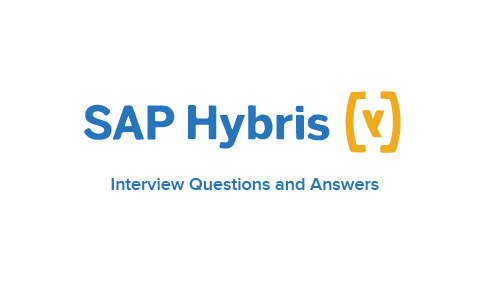SAP HANA Interview Questions
Here, we have listed all the Top SAP HANA Interview Questions and Answers for Freshers& Experienced. All the best for your interview Preparation.
What is SAP HANA?
SAP HANA is an in-memory computing engine (IMCE) used for real-time processing of huge volumes of data and building and deploying real-world applications. Adopting the row-based and column-based DB technology, SAP HANA is an advanced relational DB product serviced by SAP SE. With this high-performance analytic (HANA) system, the big data exists on the main memory and not on the hard disk.
It replaces the onus of data maintenance separately on the legacy system and simplifies the tasks of administrators in this digital world.
What is the development language used by SAP HANA?
C++
Name the operating system SAP HANA supports.
More than 70% of customers run their SAP workloads on Linux with the use of SUSE Linux Enterprise Server, which is the best OS choice for SAP HANA.
Explain Parallel Processing in SAP HANA?
Using the columnar data storage approach, the workload in SAP HANA is divided vertically. The columnar approach allows linear searching and aggregation of data rather than two-dimensional data structure. If more than one column is to be processed, each task is assigned to diverse processor. Operations on one column are then collimated by column divisions processed by different processors.
What are the advantages of using SAP HANA database?
- With the HANA technology, you can create gen-next applications giving effective and efficient results in the digital economy.
- By using singe data-in memory, SAP HANA supports smooth transaction process and fault-tolerant analytics
- Easy and simple operations using an open-source, unified platform in the cloud
- High-level Data Integration to access massive amounts of data
- Advanced tools for in-depth analysis of present, past and the future.
List the merits and demerits of using row-based tables.
Merits:
- No data approach can be faster than row-based if you want to analyze, process and retrieve one record at one time.
- Row-based tables are useful when there is specific demand of accessing complete record.
- It is preferred when the table consists of less number of rows.
- This data storage and processing approach is easier and effective without any aggregations and fast searching.
Demerits:
- The data retrieval and processing operations involve the complete row, even though all the information is not useful.
What are the advantages of column-based tables?
- Allows smoother parallel processing of data as the data in columns is stored vertically. Thus, to access data from multiple columns, every operation can be allocated to a separate processor core.
- Only specific columns need to be approached for Select query and any column can be used for indexing.
- Efficient operations since most columns hold unique values and thus, high compression rate.
Which table type is preferred in SAP HANA?
Since analytic applications require massive aggregations and agile data processing, column-based tables are preferred in SAP HANA as the data in column is stored consequently, one after the other enabling faster and easier readability and retrieval. Thus, columnar storage is preferred on most OLAP (SQL) queries. On the contrary, row-based tables force users to read and access all the information in a row, even though you require data from few and/or specific columns.
What is the main SAP HANA database component?
Index Server consists of actual data engines for data processing including input SQL and MDX statements and performs authentic transactions.
What is Persistence Layer?
The persistence layer in SAP HANA handles all logging operations and transactions for secured backup and data restoring. This layer manages data stored in both rows and columns and provides steady save points. Built on the concept of persistence layer of SAP’s relational database, it ensures successful data restores.
Besides managing log data on the disk, HANA’s persistence layer allows read and write data operations via all storage interfaces.
What is Modeling Studio?
Modeling Studio is an operational tool in SAP HANA based on Eclipse development and administration, which includes live project creation.
- The HANA Studio further builds development objects and deploys them, to access and modify data models like HTML and JavaScript files.
- It also handles various data services to perform data input from SAP warehouse and other related databases.
- Responsible for scheduling data replication tasks.
What are the different compression techniques in HANA?
- Run-length encoding
- Cluster encoding
- Dictionary encoding
What is SLT?
SLT expands to SAP Landscape Transformation referring to trigger –based replication. SLT replication permits data transfer from source to target, where the source can be SAP or non-SAP while the target system has to be SAP HANA with HANA database. Users can accomplish data replication from multiple sources.
The three replication techniques supported by HANA are:
- SLT
- SAP Business Objects Data Services (BODS)
- SAP HANA Direct Extractor Connection (DXC)
What are the replication jobs in SAP HANA?
- Master Job (IUUC_MONITOR_)
- Data Load Job (DTL_MT_DATA_LOAD__<2digits>)
- Master Controlling Job (IUCC_REPLIC_CNTR_)
- Migration Object Definition Job (IUCC_DEF_MIG_OBJ_<2digits>)
- Access Plan Calculation Job (ACC_PLAN_CALC__<2digits>)
What is Latency?
The time duration to perform data replication starting from the source to the target system is known as latency.
What are the various components of SAP HANA?
SAP HANA comprises several key components working together to deliver an in-memory database experience. Here are the main components:
- In-Memory Database Engine: This core component stores and processes data in RAM, enabling significantly faster data access and processing compared to traditional disk-based databases.
- Column Store: Data is physically stored in columns instead of rows, optimizing data retrieval for analytical workloads where specific columns are frequently queried.
- Calculation Engine: This engine performs calculations and transformations on data stored in the in-memory database, enabling real-time analytics and complex calculations.
- SQL Processing Engine: This component translates SQL queries into optimized execution plans for the in-memory database, ensuring efficient data retrieval.
- Preprocessor: This component preprocesses data before it is loaded into the in-memory database, improving data quality and optimizing storage efficiency.
- Persistence Layer: This layer ensures data durability and consistency by periodically writing data to persistent storage (e.g., flash disks).
- Replication Server: This component facilitates data replication between different HANA systems for disaster recovery, workload balancing, and data synchronization purposes.
- Studio: This is the graphical user interface (GUI) for managing and administering SAP HANA, allowing users to perform tasks like database configuration, user management, and data modeling.
- XS (eXtended Services): This framework enables developers to build web applications and services directly on top of SAP HANA, leveraging its in-memory capabilities for real-time data access and integration.
- 10. Administration Cockpit: This web-based interface provides an overview of the HANA system health, performance, and resource utilization, allowing administrators to monitor and manage the system effectively
How to perform backup and recovery operations?
During a regular operation, data is by default stored to the disk at save points in SAPHANA. As soon as there is any update and transaction, logs become active and get saved from the disk memory. In case of power failure, the database restarts like any other DB returning to the last savepoint log state. SAP HANA requires backup to protect against disk failure and reset DB to the previous state. The backups simultaneously as the users keep performing their tasks.
What is SLT Configuration?
Configuration is the meaningful information to establish a connection between source, SLT system and SAP HANA architecture as stated in the SLT system. Programmers are allowed to illustrate a new Configuration in Configuration and Monitoring Dashboard.
What is Stall?
The waiting process for data to load from the main memory to the CPU cache is called Stall.
What are different types of information views?
There are primarily three types of information views in SAP HANA, which are all non-materialized.
- Attribute view
- Analytic view
- Calculation View
What are Configuration and Monitoring dashboard?
They are SLT Replication Application Servers to provide configuration information for data replication. This replication status can also be monitored.
What is logging table?
Logging table records all replicated changes in the table, which can be further replicated to the target system.
How to define Transformation rules in HANA?
Using advanced replication settings, transformation rules are specified to transfer data from source tables during replication process. For instance, setting rules to covert fields, fill vacant fields and skip records. These rules are structured using advanced replication settings (transaction IUUC_REPL_CONT)
What is the role of transaction manager and session?
SAP HANA transaction manager synchronizes database transactions keeping the record of closed and open transactions. When a transaction is committed or rolled back, the manager informs all the active stores and engines about the action so that they can perform required actions in time.
How is SQL statement processed in SAP HANA?
Each SQL statement in SAP HANA is carried out in the form of a transaction. Every time, a new session is allocated to a new transaction.
What is Master-Controller job?
A Master-controller job is responsible to build database logging table in the source system. It further creates synonyms and new entries in SLT server admin when the table loads / replicates.
How users can avoid un-necessary storage of logging information?
Pause the replication process and terminate the schema-related jobs.
Is the table size in source system and Sap HANA system same?
When to change the number of Data Transfer Jobs?
The number of data transfer jobs change when the initial loading speed or latency replication time is not up to the mark. At the end of the initial load, the number of initial load jobs may be reduced.
Top 5 Latest SAP HANA Interview Questions for 2024:
Question: Discuss your hands-on experience with deploying and managing SAP HANA on cloud platforms such as AWS or Azure.
Answer: In my professional journey, I have actively participated in the deployment and management of SAP HANA on leading cloud platforms, including AWS and Azure. This involves tasks such as setting up HANA instances, configuring high availability, optimizing performance, and ensuring seamless integration with other cloud services. Leveraging cloud features enhances scalability, flexibility, and resource efficiency in SAP HANA deployments.
Question: Explain how SAP HANA integrates machine learning and artificial intelligence capabilities.
Answer: SAP HANA embeds machine learning (ML) and artificial intelligence (AI) capabilities through its SAP HANA Predictive Analytics Library (PAL) and Automated Predictive Library (APL). These libraries enable data scientists and developers to perform advanced analytics directly within the HANA platform. By leveraging in-memory computing, SAP HANA accelerates ML algorithms, providing real-time insights for enhanced decision-making.
Question: Describe the role of SAP HANA within the broader context of the SAP Business Technology Platform (BTP).
Answer: SAP HANA plays a pivotal role in the SAP Business Technology Platform, serving as the core in-memory database and analytics engine. It provides the foundation for advanced analytics, data processing, and application development. Within the SAP BTP, HANA seamlessly integrates with other services like SAP Analytics Cloud, SAP Data Intelligence, and SAP Fiori, fostering a holistic environment for end-to-end digital transformation. This integration ensures a unified and intelligent approach to data management and business processes.
Question: Describe the concept of a column store in SAP HANA and its advantages for analytical workloads.
Answer: The column store in SAP HANA organizes data storage by columns rather than rows. In this approach, data for a specific column is stored together, optimizing analytical queries that typically access a subset of columns. This design enhances compression, accelerates data retrieval, and enables advanced analytics, making SAP HANA well-suited for analytical workloads.
Question: How does SAP HANA handle data persistence and recovery, considering its in-memory nature?
Answer: Given its in-memory architecture, SAP HANA utilizes a combination of techniques for data persistence and recovery. While the primary data resides in memory for rapid processing, periodic save points and log persistence mechanisms ensure data durability. In case of a system failure, SAP HANA reconstructs the database state using the log entries and save points, minimizing data loss. This hybrid approach balances the benefits of in-memory performance with the necessity of data persistence and recovery.





